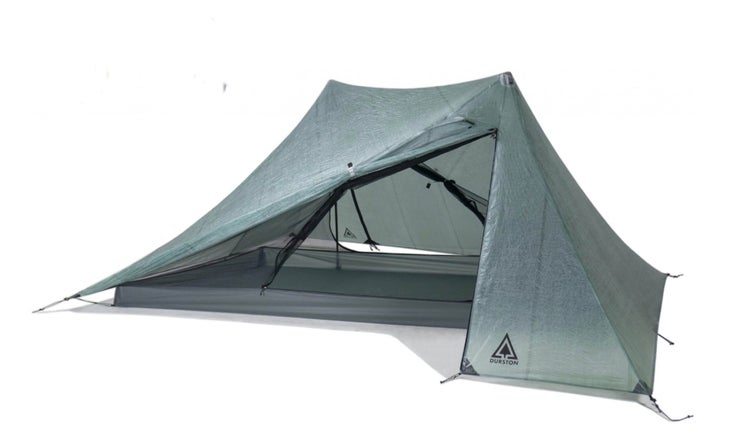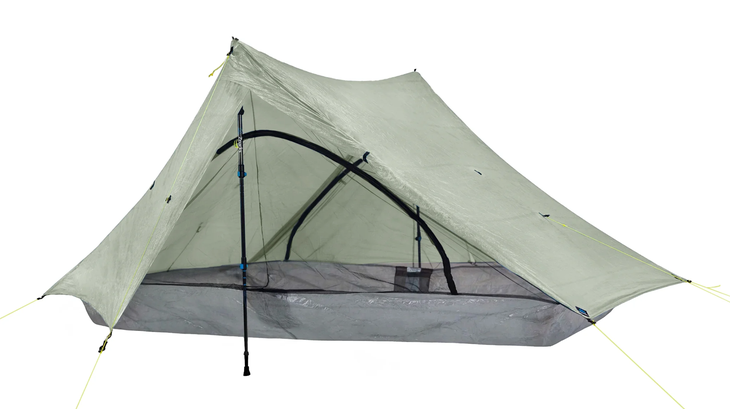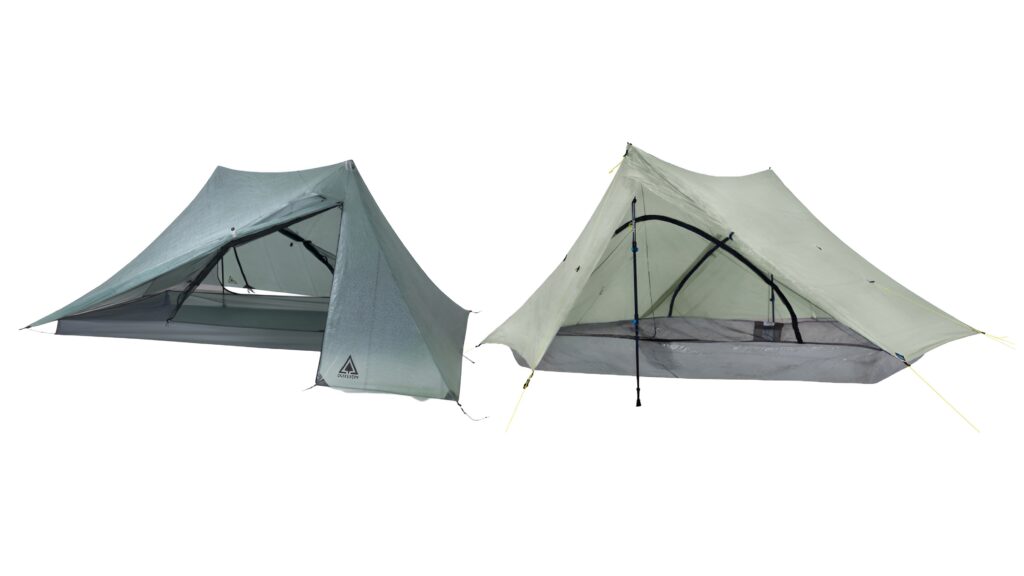Products You May Like
Heading out the door? Read this article on the new Outside+ app available now on iOS devices for members!
Download the app.
Aspiring ultralighters have a lot of tough gear decisions to make, but choosing the right shelter has to be at the top of the list. A tent is one of the most substantial items in anyone’s pack, and an upgrade could knock pounds from your baseweight. If you’re considering top-end models, your shelter will likely also be the biggest single-item expense you’ll make—premium shelters made from Dyneema often top $600. To aid your decision, we’ve put together an exhaustive comparison of two of the best-selling models: the Zpacks Duplex and the Durston Gear X-Mid Pro 2.
At first glance, the two shelters are remarkably similar. Both are 2-person Dyneema tents with similar features: dual side entry, single-wall, set up using trekking poles, and light enough to be used as one-person tents. They are roughly the same size, nearly the same weight, and have similar price tags. What’s more, both are extremely popular amongst hardcore thru-hikers and ultralighters, and tend to receive glowing reviews. Nonetheless, there are differences between the two, and the most substantial of these differences come down to design, rather than construction or intended use.

Weight: 20.2 oz
Price: $679
When it comes to design choices, the Durston X-Mid is the black sheep of the ultralight shelter world. In short, the X-Mid has an offset design: Where the Duplex (and most other trekking-pole tents) is set up with poles at the midpoint of the tent, the X-Mid’s poles are offset with one towards the feet and the other towards the head. This sounds like a pretty small detail, but it has a big impact on how the tent functions. Because the poles are offset, everything else is as well—the bathtub floor, the ridgeline, the vestibules, even the angle of the tent walls.
In practice, this allows for vestibule space while having a simple rectangular footprint. Crucially, the rectangular fly makes set-up simpler than just about any other trekking-pole tent, including the Duplex. Set up for both tents begins with staking out the four corners, and then erecting the trekking poles. With the X-Mid, you can stop there, though extra stakes are still a good idea in windy or wet conditions. The Duplex requires a few extra steps—staking out the vestibule, adjusting the guylines on the corner stakes, and often, re-staking the corners to even out the tautness of the pitch. The Duplex isn’t exactly difficult to set up once you’re used to it, but the X-Mid is simpler, full stop.
The X-Mid’s design also means that it is slightly roomier than the Duplex, though neither tent feels cramped. Nonetheless, the X-Mid does offer more overall square footage and three inches more width than the Duplex. Both tents are wide enough to accommodate two 20-inch wide pads; neither will fit two 25-inch wide pads.
There are a few consequences to that offset design. For starters, the tent walls don’t have a constant angle in relation to the living quarters. If you’re using the X-Mid as a one-person tent, that’s basically a positive, because you can adjust your position so that your head is beneath the steepest aspect, effectively making the tent feel roomier. But with two people side-by-side, one person will be dealing with the lower-angled side of the tent, which will feel more cramped and potentially face more condensation issues. One way to alleviate this is to sleep head-to-foot, but our testers quickly decided that wasn’t a great option. In real-world scenarios, where the ground is rarely perfectly level, one person will almost always be sleeping with their feet elevated. Oddly, our testers noted that the X-Mid feels larger when used solo, while the Duplex feels larger when shared by two people thanks to the constant angle of the walls and the ridgeline that sits directly overhead.
A quick side note on offset pole design: While it’s uncommon, it isn’t wholly unique to the X-Mid. That said, there are no other tents on the market that offer all of the features the X-Mid does. Compared to another offset-pole tent—the Sierra Designs High Route—the X-Mid has larger vestibules and is far lighter thanks to its DCF construction. Another offset Dyneema shelter—the Tarptent Stratospire Li—has other differences to note: a hexagonal footprint that requires more stakes, and full double-wall construction that clocks in about 10 ounces heavier than the X-Mid Pro 2.

Weight: 18.5 oz
Price: $669
Until the arrival of the X-Mid Pro a few years ago, the Duplex was the undisputed champion of top-shelf ultralight Dyneema tents. Despite the X-Mid’s growing popularity, the Duplex still has a lot to offer.
The most obvious perk of the Duplex is in customization options—there are three distinct versions to choose from. The baseline model has a zipperless vestibule, with coverage provided by the overlapping design of the vestibule doors. However, for an extra $30 and 1.9 ounces, a zippered vestibule is available. There’s also the DupleXL option, designed for taller users with six extra inches of floor length. Finally, there’s an optional freestanding add-on, which was one of our favorite features on this tent. For a weight penalty of 10.2 ounces, the kit adds four poles that transform the Duplex into a perfectly serviceable freestanding tent. While the freestanding version of the Duplex is slightly fussier to set up than your standard dome tent, it functioned perfectly atop tent platforms in crowded campsites in the White Mountains. When you’re spending nearly $700 on a tent, it’s nice to have add-ons that make it usable in a variety of situations.
Compared to the X-Mid, the fly of the Duplex offers slightly less coverage, especially if you don’t have the knowledge or inclination to adjust the pitch of the Duplex carefully. We did experience more splashback and windblown snow getting in under the rainfly—one tester was surprised to wake up with snow in the tent after a windy April snowstorm outside Bend, Oregon. While it’s possible to batten down the rainfly of the Duplex, the full coverage of the X-Mid’s fly is reassuring in comparison. That said, the Duplex’s extra-tall eight-inch bathtub floor helps to keep the elements at bay, and with a bit of practice, it’s fairly simple to adjust the stakes in order to raise or lower the fly (a longer and wider pitch will raise the fly, closer will lower it).
In terms of construction, there aren’t many differences to note. One exception is the floor—the Duplex opts for a Dyneema floor (at 1.0 oz/sq yd, the floor material is thicker than the fly), while the X-Mid scraps the Dyneema in favor of 15d nylon. In practice, testers didn’t notice much difference in durability between the two. The larger effect was in packability; the nylon allows the X-Mid to pack down smaller (its stuff sack is about two inches narrower in diameter). Another difference is in how the tent fabric is held together. The Duplex uses more traditional sewn and taped seams, while the X-Mid uses a newer process called hot bonding, which bonds the seams without using thread.
The Verdict
Need flexibility for taller backpackers, more headspace for two hikers, or the versatility of a freestanding option? The Duplex offers all these features. Otherwise, it’s hard to beat the simple but effective design of the X-Mid.
